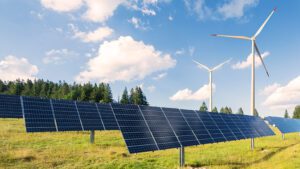Clean energy funds, once a favourite in the investment trust landscape, are poised for a resurgence as lower interest rates reignite investor interest.
After years of high premiums and booming demand driven by environmental, social, and governance (ESG) concerns, the sector has faced headwinds from rising rates and easing power prices. However, with the Bank of England recently lowering interest rates for the first time in over four years, and further cuts anticipated in 2024, optimism is returning.
According to data from the Association of Investment Trusts, clean energy funds traded at significant premiums to their net asset values (NAV) as recently as 2020. For example, Greencoat UK Wind, the largest clean power investment trust, raised over £1 billion in equity during 2020 and 2021, almost a third of its stock market value. But today, the fund and its peers are trading at discounts, reflecting the broader market’s retreat from the £15.5 billion sector amid higher interest rates and softer energy prices.
James Wallace, an analyst at Winterflood, believes the recent rate cuts could help narrow these discounts, though the impact might take time to materialise fully. “We think that these interest rate cuts will narrow this gap, at least somewhat in terms of discounts, because of the lower required returns demanded by these investors,” he said. However, Wallace cautioned that substantial cuts—potentially up to 75 basis points—may be needed to see a meaningful impact on valuations.
Still, questions remain about whether green energy funds can reclaim the high premiums of the past without a return to the ultra-low interest rates seen pre-2020. Ben Newell, an analyst at Investec, noted, “It’s feasible that these companies trade at or around NAV, but unless you’ve got the rates we saw pre-2020, they’re not going to trade on 10 to 20 per cent premiums to book value.”
The challenges are not confined to interest rates. London’s emerging battery storage sector, including funds like Gresham House Energy Storage and Gore Street Energy Storage Fund, faces scrutiny over volatile cashflows, with share prices trading between 45 and 55 per cent below their NAVs. Unlike wind or solar assets, battery storage revenues depend on fluctuating wholesale power prices, adding a layer of risk that investors have been hesitant to embrace.
Paul Mason, Chief Investment Officer at Harmony Energy, highlighted the unpredictability of revenues from battery assets as a key factor in the current market discount. Recent declines in energy prices have further pressured these funds, leading some, such as Harmony and Gresham, to scrap dividends for the year. Max Slade of Harmony Energy reflected on the lesson learned, stating, “The lesson we’ve learnt has been that taking an asset class that has [an unpredictable] merchant revenue profile and trying to pledge a fixed level of dividend is not always deliverable.”
Additionally, the waning enthusiasm for ESG strategies during economic downturns has affected green infrastructure funds. Last year, ESG funds saw significant withdrawals from British investors, although flows have improved this year. “During a cost of living crisis and when things are a bit slower in the economy, the focus can be a bit more on the economics and making returns,” Wallace noted.
The recent dip in share prices below NAV has hindered renewables investment trusts from raising new equity, constricting a vital funding source for future projects. The Renewables Infrastructure Group (Trig), one of the largest trusts in the sector, has responded by managing its balance sheet carefully, including selling £210 million in assets to reduce debt and fund new developments.
With the UK government setting ambitious targets to expand wind and solar capacity by the end of the decade, the role of private capital remains crucial. However, as Alex O’Cinneide, CEO of Gore Street Capital, pointed out, the constriction of capital access poses a significant challenge: “There’s a very big issue there about what it means in terms of a new government, in terms of the build-out of our renewables infrastructure, that a main avenue for private capital to go into renewables in the UK is intrinsically shut.”
As the sector looks to recover, all eyes will be on further interest rate adjustments and their potential to revitalise investor confidence in the green energy space.

























